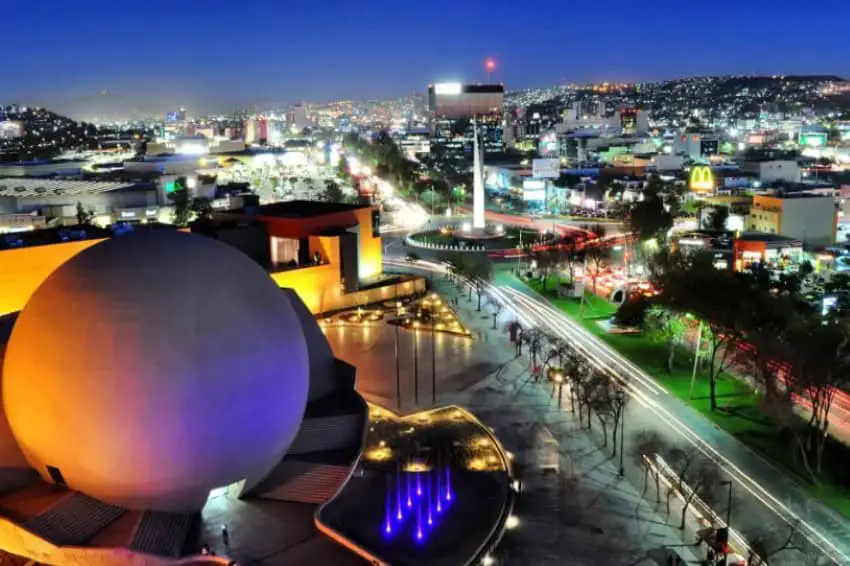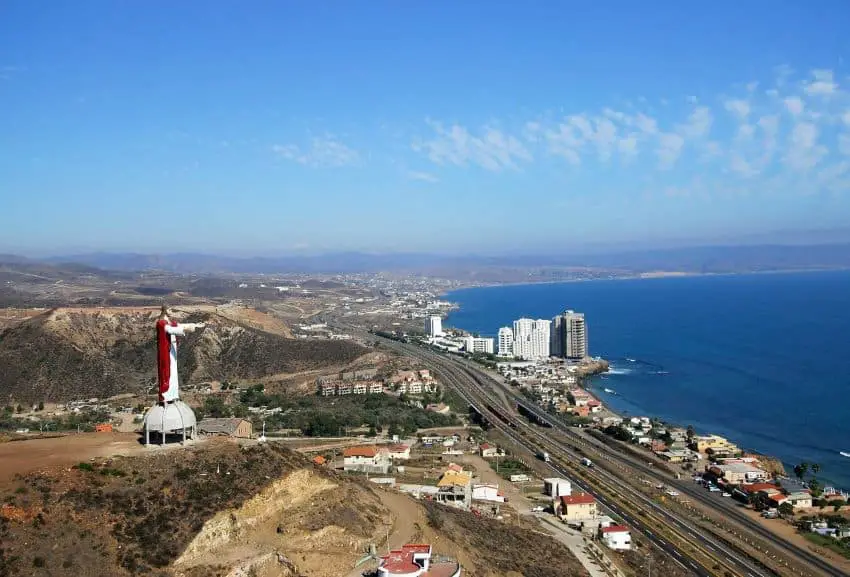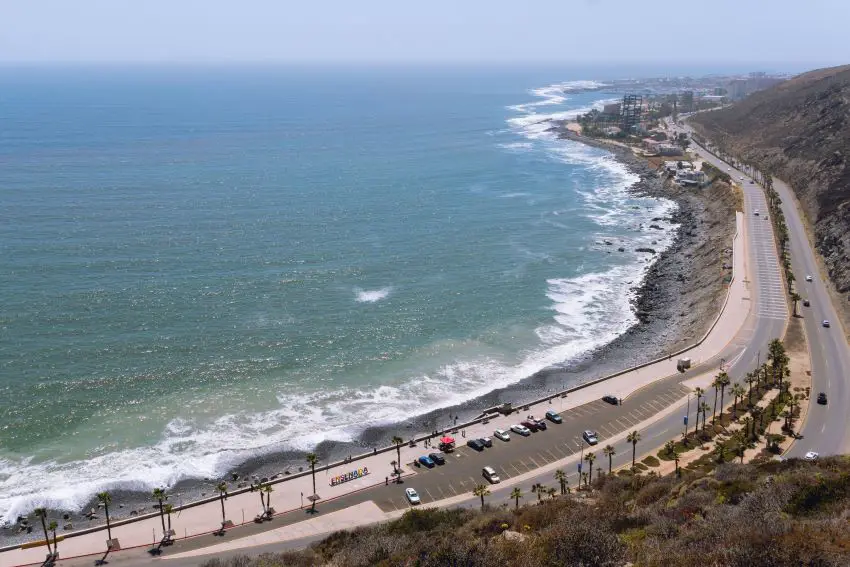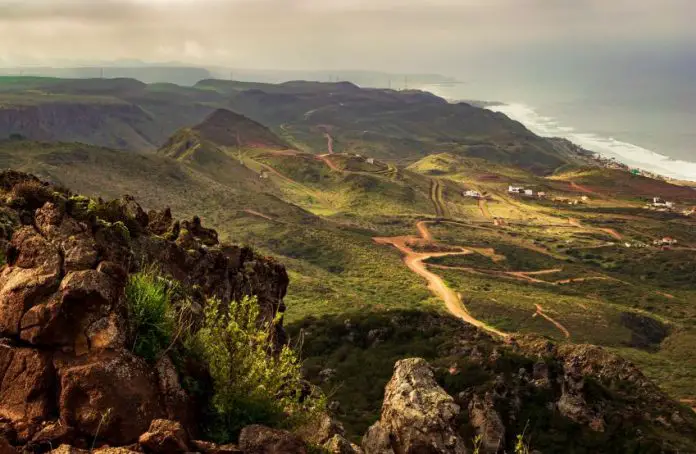Most of the Mexico-U.S. border might feel like an off-limits option in today’s binational immigration and security environment. There are six Mexican states across this line in the sand and there’s not much good news coming from either side of “la frontera.” Yet one state (Baja California, which comprises of the northern half of the Baja California peninsula) should draw your attention, for a lifestyle where straddling U.S. and Mexico living might make for the perfect combination of foreign and familiar.
I get asked “Why do you live in Mexico?” by friends and acquaintances, especially when traveling to the U.S. or overseas. If I want to boil down the Mexico living rationale, I often resort to a refrain that sums up this country’s most salient advantage when comparing Mexico with other overseas living options: “foreign and familiar” — a mixture of cultural, culinary, linguistic, historical, and societal expressions co-existing with Mexico’s acceptance and embrace of many things “American” — peanut butter on your morning toast, pyramids in the afternoon; colonial cities and Costco; el Beis (baseball) and birria. I could go on and on.

It’s a region of Mexico with a high degree of familiarity for West Coasters (a Tijuana day trip is a rite of passage for those growing up in SoCal), albeit a mystery to many others exploring coastal living options in Mexico. It’s a place that has sourced many, many stereotypical portrayals of Mexican identity (sometimes unfairly), while also carving out a bicultural hybrid identity that might someday call into question whether a walled border even matters. The urban complex, San Diego-Tijuana, is already one of the hemisphere’s most energetic landscapes of cooperation and entwined destinies. Being a part of this future might just be your Mexico living sweet spot.
Hands down, Baja California is the only place to live on the coast enjoying a “Mediterranean” climate of warm (but rarely humid) summers and winters with seasonal rains and a very stable mean daily temperature. Like San Diego, there will be overcast mornings and don’t expect tropical greenspaces or forested hills.
Connectivity and Care also earn high marks, as Baja living gifts its inhabitants with the best of Mexico and the U.S. when it comes to getting back home (using San Diego and Tijuana airports for domestic and international flights) and the best of border medicine with Medicare. Sure, you’ll need to get past layers of highway obstacles and a relatively slow international border crossing reality, but San Diego is pretty much within your grasp. Well, unless you opt for Ensenada a further 144 kilometers (89 miles) away.
I would never discount or degrade the culture of Baja California, coopted by U.S. commercial and popular cultural incursions. But the state has also earned its own independence and identity when it comes to lifestyles, artistic expressions and familial and societal relations in defiance of California’s tidal wave of influences. No, you won’t find iconic Mexican relics of archaeology, Spanish colonial architecture, or jaw-dropping landscape diversity. Here, it’s mostly desert, especially if you’re heading inland away from the Pacific. You’ll need to take a flight (three hours to Mexico City) to get your fix of “real” Mexico.
That said, you’ll find plenty of reasons to explore your local surroundings: Tijuana’s sophisticated dining and multicultural performing arts scene, Mexico’s premiere wine country (just over the hill from Ensenada), beaches and more beaches, and two magnificent bodies of water (the Pacific Ocean and the Gulf of California).
Tijuana

Starting with Tijuana, there are probably more U.S. passport holders living full and part-time than in any other state. English is widely spoken. With 2.1 million metro-area residents, universities, museums, performing arts (Teatro Las Tablas, Centro Cultural Tijuana, Casa de la Cultura), and some of Mexico’s most innovative seafood, Tijuana defies the stereotypes of its past.
Tijuana is a manufacturing powerhouse and as a result, offers non-stop flights to China. Some 45,000 K-12 students and 45,000 others head into California for work and school every day. A post-COVID-19 sea of remote workers takes advantage of lower cost of living (although this has led to a rise in rental costs), income-tax savings (heard of the Foreign Earned Income Exclusion?) and a cultural spark that’s just not found in the States.
But there are security issues. Crime, cartel violence, car-jackings, and the ever-menacing border tension realities loom over the area. More U.S. citizens are homicide victims in Baja California State than in any other state in Mexico. A commute to the States for work is brutal by most accounts (50 million annual border crossings happen here). Remote workers experience less stress. As one social media post highlights, “If you want to make the sacrifice, have an end game; don’t be another hamster on the wheel or you’ll go crazy.”
Rosarito

Rosarito (population 127,000); what can you say about it? What started as a humble beach town with a wooden pier and lifeguard stations (another nod to the SoCal beach experience) has grown into a bedroom community for Tijuana and high rise condo towers for thousands of foreigners. Highway 1 and 1D form arteries that run smack dab through the center of town. In some ways, living here is more about convenience than culture or even “resort” amenities. It’s a surfer haven for some and a breakfast club or happy hour social scene for others.
Gated residential communities line the coast north and south of the city center. More a “mistake” of development than anything very cohesive, the city never rates in the top ten for Mexican beach resorts with a “wow factor.” There are some high-rise beachfront hotels, but few visitors come for long vacation stays, meaning the weekend “invasion” is more the cycle.
But it is Mexico’s lobster capital. Puerto Nuevo in particular has Baja-Med cuisine (making dining here expensive by Mexican standards), micro-breweries and Mexico’s biggest annual beach party, Baja Beach Fest, in August. There is a muted multicultural art scene centered around painting and sculpture, and two English-language theater companies. You’ve got convenience, a daily mean temperature of 70 degrees Farenheit (21 Celcius), and sandy Pacific beaches. Oh, and Rosarito was the source of rocks for the 1970’s Pet Rock craze.
Ensenada

An hour’s drive to the south is Ensenada, described by one travel guide as “hedonistic Tijuana’s cosmopolitan sister.” It’s big enough (population 444,000) to stand on its own when it comes to services and amenities and it’s far enough from the border (104 km) to require some effort to get here. This all makes for a haven from the border calamity up north. And Ensenada’s Mexican and expat societies enjoy shared coastal living experiences that can be harder to find in Mexico’s “fly-in,” more trafficked beach locations.
Those who make the effort to get here (and live year round) are rewarded with a seaport personality and the arrival of 3 to 4 ships per week, Mexico’s best seafood dining and the premier wine country (just over the hill in Valle de Guadalupe), surprising micro-climates should the cool overcast weather grows tiresome and affordability. There are universities and research institutes, some offering courses in English in marine science, winemaking and other interests. Museo de la Historia, Plaza de la Patria and Ventana al Mar Park are all casual hang-outs for expats.
You’ll also find a diversity of residential neighborhoods in central Ensenada and many more toward the south of the city. You’ll want a car if you live here, and some reports say beach swimming in central Ensenada is not recommended, due to sewage spills — more prevalent in winter than summer. Sound familiar, SoCal?
Baja California living straddles the U.S. and Mexico, drawing the best conditions for a “foreign and familiar” lifestyle. It’s SoCal with an accent, a tribute to the challenges and rewards of a binational landscape.
The ratings
A full breakdown of our rating system can be found here.
![]()
What did we get right? What do you disagree with? Let us know in the comments.
You can see more of our Where to Live in Mexico 2024 series here, including ratings for Yucatán, Oaxaca and Quintana Roo.
Author Greg Custer lives in Mexico. He’s worked for over 40 years in international tourism, educating travel advisors around the world about Mexico and other Latin American destinations. He helps folks explore Mexico for living at www.mexicoforliving.com.

what about Baja Sur, especially Todos Santos and La Paz?
Coming next week…
Seriously? I love Mexico and am down there at least every 6 weeks. BUT I wont go anywhere within 100 Km of the entire US / Mexico Border. Just run the crime stats all along the border they are the highest in all of Mexico. I used to go to TJ and Rosarito and Ensenada all the time … but .. stopped going about 10 years ago its not the same let alone living there … Im sorry to disagree with you but the proof is in the numbers.
I agree and posted an article stating how the six border states (including Baja Cal) have very disturbing crime realities. That doesn’t change how tens of thousands of US citizens decide to live here. Baja Cal is by no means a highly rated region when compared with other States. But leaving it out of this essay series would also not serve the MND readers. Thank you for commenting.
What about San Felipe and points south on the Sea of Cortes??
Totally disagree with most of the comments. I have lived in Baja California for now almost 10 years and the number of Americans moving here has stressed the infrastructure to the max. Frequent water outages, no sewerage treatment, rapid growth to accommodate the americanos, and no infrastructure to support that kind of growth. I am seriously considering moving away from the border communities because of the uncontrolled growth. This influx has also caused prices to rise out of control and the Mexican people can’t even live in their own communities. Same thing happened in Acapulco and Cabo San Lucas. Sad but true. I speak Spanish and have a permanent residency visa and most people moving here speak no Spanish, don’t want to learn and don’t even know what a tourist visa is. Retell the story you posted only make it real. And your graph you posted is unreal. All you are doing in making the existing problem worse. Shame on you for that.
I,too, am more interested in Baja Sur and hope you will cover Loreto, Loreto Bay, and other Sea of Cortez locations. Not just Cabo and Todos Santos. Thank you
Coming soon….
I totally disagree with with most of the above statements about the actually living conditions and agree with Americans bring there “Exceptionalism” with them, as well as a little of knowledge about the history of the country (there is alot to learn regarding US and Mexican relations) and thinking English is more important than Spanish. They often forget they are guests and immigrants.
I have been traveling through out Mexico for around forty years, spending alot of time as a vacation tourist FMM live in and now I am legal resident of the Baja. Before becoming a legal resident I lived 7 miles from the International Border in Chula Vista, Ca. I believe perspective has alot do with how people see the overall framework of what is happening in Baja.
Yes, the population is growing and so is the perception of how this area is changing. For example; yes many cruise ships come to Ensenada weekly and as a result city crews repair and build new roads, build infrastructure, mow the grass and trim the trees etc. The Ensenada Police department has a leadership program for youth. Tijuana is building a large double deck highway along the border wall to help people get to the coast quicker. Most likely the success of Valle de Guadalupe ( world famous wine region ) has helped fund the new highway as well as other projects. The “Silk Road” ( TJ to Ensenada Toll Road ) which brings produce and other items to the USA is constantly being repaired and maintained for traffic usage.
This is an area on the move and has all the new growth pains of very desirable living area. With this in mind, the new economic wealth, the talented workforce and young people that care about the environment and their country has me believing Baja’s position will improve greatly over the next decade. This country has a long history of adaptation and survival, like 10,000 years or so… I am optimistic.
Thank you Julie! I want to see optimism and believe BC can stand on its two feet in defiance of international border striff. As the CA water situation improves I suspect BC ground water supplies are equally benefiting. No one can stop growth in this region, only hope a youth movement will better define the future. As in the rest of Mexico, it comes down to good municipal governance and people standing up for accountability, law enforcement, and some degree of long-term urban planning (all in short supply, unfortunately).
You are welcome Greg. i live in Bajamar, which is a beautiful community between Rosarito and Ensenada. I love it here because Bajamar is multi-cultural. There are many expats from the US. Many of them are Mexican nationals and some are dual citizens born in Mexico went to work in the US and now have come home. We have folks from Chile, Scotland, Venezuela, England, Japan, China and Canada etc.
One of the most recent positive movements in this area is the AMPI, a professional real estate group. The members are licensed, educated and help people understand the culture of living in Mexico.
Many folks come into Mexico and do not understand USA licensed Realtors do not have reciprocity. Most California’s do not understand there are no legally sanctioned ” escrow companies” as they know them. There are settlement companies named escrow companies. It is my understand there is no legal framework as of yet supporting the consumer when it comes to settlement services. So, having the appropriate licensed and educated real estate agent licensed in the Mexican state you are purchasing or renting is extremely beneficial.
I lived and worked at UABC in Ensenada for 11 years. I thoroughly enjoyed my time there. As a faculty member I had many local friends, including some who owned restaurants and wineries. The climate overall was superb. The expats I met were rarely integrated into the local society. The infrastructure and bureaucracies were dreadful, and the water supply is dire. The long term living situation, including the wine vallies, is moot. I experienced water shut-offs daily in summers and wild electric fluctuations. I finally left there for Guanajuato and now live in SanMiguel. God bless Mexico!
Solid article. I moved to borderland Baja after over 5 years in Cabo/Todos Santos, and I’ve never looked back.
Weather is pleasant year-round up here, unlike Cabo. There is a cosmopolitan/educated/culturally-savvy side to life here that is non-existent in Cabo (which is basically one mega resort with flip-flop culture and an endless stream of clueless gringos.)
Crime is high — as it is in most bordertowns around the world. But it’s never boring here. The proximate border means there’s a constant throughput of people – rich, poor, insane, you name it. And lots of young, university-age “kids” on both sides of the border.
There are ways around the border wait. Many buy the medical pass for $30 to jump the line. You can also time the crossing by watching traffic patterns, get Sentri, or walk across in 5 minutes at El Chaparral/PedWest.
The ONLY thing inferior is the colder water….but there is actually a lot more surf on this coastline than Cabo, because there’s something to ride year-round. Cabo goes dormant for weeks/months at a time.
I’ve been embarrassed to be an American most of my adult life. I even know how to say that in Spanish…
A Mexican long time Baja friend grins each time I say that phrase. His is a big grin.
To discover Baja and its people ages back was a life affirming event.
My strong desire to be away from most expats decades back then had me thrilled to discover Guerrero Negro.
GN is arguably one of the most forlorn little hamlets on the endlessly windy Pacific side. Always cold too.
GN’s only reason for existence is its vast salt reserves. Knowing that NO ONE who knows me will even consider asking me for a friendly visit to my ugly sanctuary just off the main highway helps me fall asleep peacefully each evening.
Que bueno…
I have lived full time in Tijuana since 2014, after living here part time since 2009 when I bought a house to live with my girlfriend. There is a lot to like about Tijuana. For me, a key is easy access to San Diego, as I am on Medicare, and all of my doctors are in San Diego. It is also where I play softball several times a week. In addition, it is about 140 miles to my son’s house. I have a Sentri pass which allows me to cross the border quickly. I try to get back south of the border by 3 to avoid the rush of people returning from work in the US.
The cost of living is significantly better than in the US, especially in the area of housing. This is causing some issues, as people are moving to Tijuana to be able to afford housing. That influx and increase in demand has given rise to multiple high rises in the downtown area, and pushed rents up all over the city. That in turn has caused issues for the locals. Another issue effecting the housing market is the influx of more manufacturing facilities, bringing more workers. I think the population of TJ is well above the 2.1 MM quoted in the article, and, growing.
Urban planning appears to be severely lacking. The Via Rapida, the main limited access road, is overburdened, with few options to improve. As mentioned above, the double decker road being built to take people to Rosarito will help alleviate the backup seen there, particularly on weekends. There is also construction in process to open another border crossing facility east of Otay. It will be a toll operation, and may help border crossing times. Water service is frequently shut down one day a week to conserve water.
The amount of drug and human trafficing smuggling that occurs at the border with San Diego is very lucrative. That leads to fights for control of the territory. This has gotten worse, as now the drug usage in TJ has also increased, and now the violence is spreading to corner drug dealers. Lots of police activity, including local, National Guard, and even the army at times. I stay away from downtown (I live about 5 miles south), and haven’t had any issues personally.
One of the great things about Mexico is the people. People have been very accepting of me, and I have a good group of friends and neighbors. While I am not fluent, my Spanglish gets me by most of the time, and there’s always Google Translate. (I know, shame on me!)
So, for me, Tijuana works well. I think where you want to live in Mexico depends on your individual circumstances.
San Felipe, easy drive from Border (Mexicali). Seaside homes, fishing, largest solar community in Mexico. Great food, medical, Assisted Living, etc. Beautiful desert & Mountains.